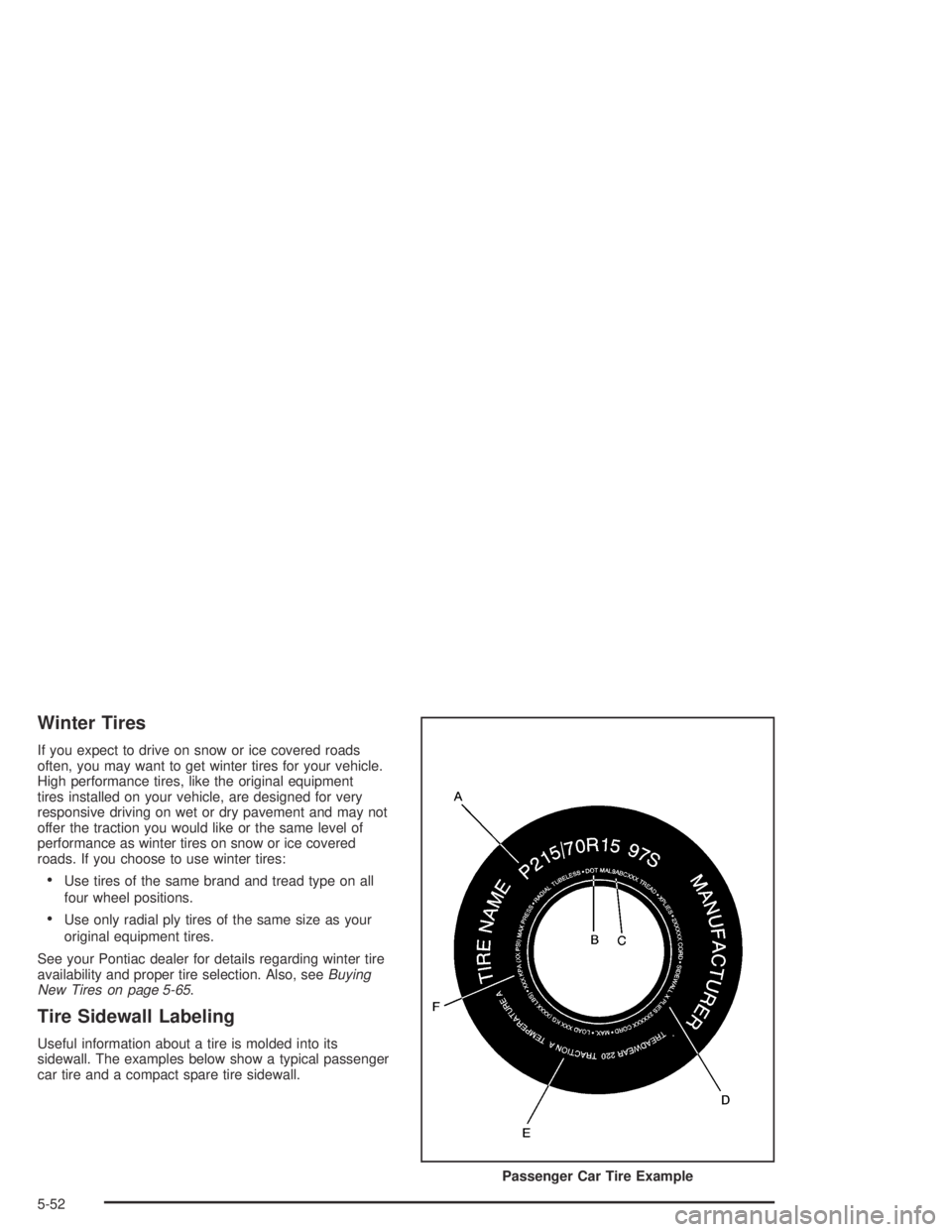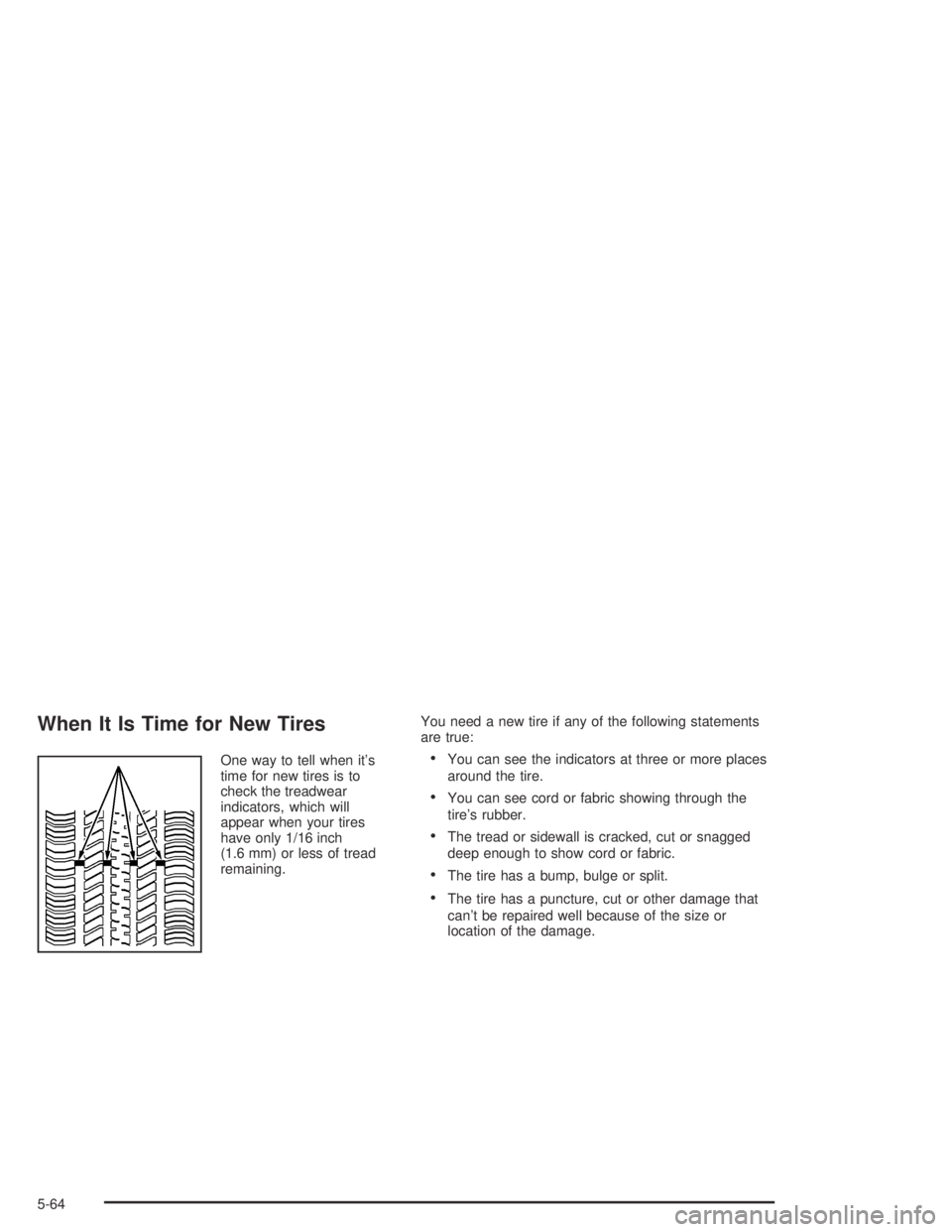tire size PONTIAC GTO 2004 Owners Manual
[x] Cancel search | Manufacturer: PONTIAC, Model Year: 2004, Model line: GTO, Model: PONTIAC GTO 2004Pages: 326, PDF Size: 2.24 MB
Page 185 of 326

Tire and Loading Information Label
A. Vehicle Capacity WeightThe Tire and Loading Information label shows the
seating capacity and the total weight your vehicle can
properly carry. This weight is called the vehicle capacity
weight. The Tire and Loading Information label is
attached to the center pillar, near the driver’s door latch.
The Tire and Loading Information label also gives you
the size and recommended inflation pressure for
the factory-installed, original equipment tires on your
vehicle at the maximum vehicle capacity weight.
For more information on tires and inflation seeTires on
page 5-51andInflation - Tire Pressure on page 5-58.
There is also important loading information on the
Certification label. It tells you the Gross Vehicle
Weight Rating (GVWR) and the Gross Axle Weight
Rating (GAWR) for the front and rear axle; see
“Certification Label” later in this section.
4-31
Page 242 of 326

Winter Tires
If you expect to drive on snow or ice covered roads
often, you may want to get winter tires for your vehicle.
High performance tires, like the original equipment
tires installed on your vehicle, are designed for very
responsive driving on wet or dry pavement and may not
offer the traction you would like or the same level of
performance as winter tires on snow or ice covered
roads. If you choose to use winter tires:
•Use tires of the same brand and tread type on all
four wheel positions.
•Use only radial ply tires of the same size as your
original equipment tires.
See your Pontiac dealer for details regarding winter tire
availability and proper tire selection. Also, seeBuying
New Tires on page 5-65.
Tire Sidewall Labeling
Useful information about a tire is molded into its
sidewall. The examples below show a typical passenger
car tire and a compact spare tire sidewall.
Passenger Car Tire Example
5-52
Page 243 of 326

(A) Tire Size:The tire size is a combination of letters
and numbers used to define a particular tire’s width,
height, aspect ratio, construction type and service
description. See the “Tire Size” illustration later in this
section for more detail.
(B) Department of Transportation (DOT):The
Department of Transportation (DOT) code indicates that
the tire is in compliance with the U.S. Department of
Transportation Motor Vehicle Safety Standards.
(C) Tire Identi�cation Number (TIN):The letters and
numbers following DOT code are the Tire Identification
Number (TIN). The TIN shows the manufacturer
and plant code, tire size, and date the tire was
manufactured. The TIN is molded onto both sides of the
tire, although only one side may have the date of
manufacture.(D) Tire Ply Material:The type of cord and number of
plies in the sidewall and under the tread.
(E) Uniform Tire Quality Grading (UTQG):Tire
manufacturers are required to grade tires based on three
performance factors: treadwear, traction and
temperature resistance. For more information see
Uniform Tire Quality Grading on page 5-66.
(F) Maximum Cold In�ation Load Limit:Maximum
load that can be carried and the maximum pressure
needed to support that load. For information on
recommended tire pressure seeInflation - Tire Pressure
on page 5-58andLoading Your Vehicle on page 4-30.
5-53
Page 244 of 326

(A) Temporary Use Only:The compact spare tire or
temporary use tire has a tread life of approximately
3,000 miles (5 000 km) and should not be driven
at speeds over 65 mph (105 km/h). The compact spare
tire is for emergency use when a regular road tire
has lost air and gone flat. SeeCompact Spare Tire on
page 5-77andIf a Tire Goes Flat on page 5-70.
(B) Tire Ply Material:The type of cord and number of
plies in the sidewall and under the tread.
(C) Tire Identi�cation Number (TIN):The Tire
Identification Number (TIN). The TIN shows the
manufacturer and plant code, tire size, and date the tire
was manufactured. The TIN is molded onto both
sides of the tire, although only one side may have the
date of manufacture.
(D) Maximum Cold In�ation Load Limit:Maximum
load that can be carried and the maximum pressure
needed to support that load. SeeCompact Spare Tire
on page 5-77andLoading Your Vehicle on page 4-30.
(E) Tire In�ation:The temporary use tire or compact
spare tire should be inflated to 60 psi (420 kPa).
For more information on tire pressure and inflation see
Inflation - Tire Pressure on page 5-58.
(F) Tire Size:A combination of letters and numbers
define a tire’s width, height, aspect ratio, construction
type and service description. The letter “T” as the
first character in the tire size means the tire is for
temporary use only.
Compact Spare Tire Example
5-54
Page 245 of 326

Tire Size
The following illustration shows an example of a typical
passenger car tire size.
(A) Passenger (P-Metric) Tire:The United States
metric tire sizing system uses the letter “P” to designate
a passenger vehicle tire. The European metric tire
sizing system does not use the letter “P” to designate a
passenger vehicle tire.(B) Tire Width:The three-digit number indicates the
tire section width in millimeters from sidewall to sidewall.
(C) Aspect Ratio:A two-digit number that indicates
the tire height-to-width measurements. For example, if
the tire size aspect ratio is “70,” as shown in item “C” of
the illustration, it would mean that the tire’s sidewall is
70% as high as it is wide.
(D) Construction Code:A letter code is used to
indicate the type of ply construction in the tire. The
letter “R” means radial ply construction; the letter “D”
means diagonal or bias ply construction; and the
letter “B” means belted-bias ply construction.
(E) Rim Diameter:Diameter of the wheel in inches.
(F) Service Description:These characters represent
the load range and the speed rating of a tire. The
load range represents the load carry capacity a tire is
certified to carry. The speed rating is the maximum
speed a tire is certified to carry a load. Speed ratings
range from “A” to “Z”.
5-55
Page 248 of 326

UTQGS:Uniform Tire Quality Grading Standards, a tire
information system that provides consumers with
ratings for a tire’s traction, temperature and treadwear.
Ratings are determined by tire manufacturers using
government testing procedures. The ratings are molded
into the sidewall of the tire. SeeUniform Tire Quality
Grading on page 5-66.
Vehicle Capacity Weight:The number of designated
seating positions multiplied by 150 pounds (68 kg)
plus the rated cargo load. SeeLoading Your Vehicle on
page 4-30.
Vehicle Maximum Load on the Tire:Load on an
individual tire due to curb weight, accessory weight,
occupant weight and cargo weight.
Vehicle Placard:A label permanently attached to a
vehicle showing original equipment tire size and
the recommended cold inflation pressure. SeeLoading
Your Vehicle on page 4-30.In�ation - Tire Pressure
Tires need the correct amount of air pressure to operate
effectively.
Notice:Do not let anyone tell you that
underin�ation or overin�ation is all right. It is not. If
your tires do not have enough air (underin�ation),
you can get the following:
Too much �exing
Too much heat
Tire overloading
Premature or irregular wear
Poor handling
Reduced fuel economy
If your tires have too much air (overin�ation), you
can get the following:
Unusual wear
Poor handling
Rough ride
Needless damage from road hazards
5-58
Page 249 of 326

A Tire and Loading Information label is attached to your
vehicle’s center pillar, below the driver’s door latch.
This label lists your vehicle’s original equipment
tires and their recommended cold tire inflation pressures.
The recommended cold tire inflation pressure, shown
on the label, is the minimum amount of air pressure
needed to support your vehicle’s maximum load carrying
capacity. For more information regarding how much
weight your vehicle can carry, seeLoading Your Vehicle
on page 4-30.How you load your vehicle affects vehicle handling and
ride comfort. When driving with less than the maximum
load capacity allowed for your vehicle, you can set
tire inflation pressure to the recommended amounts
shown in the following chart. Never load your vehicle
with more weight than it was designed to carry.
Tire SizeRecommended Cold Tire In�ation
Occupant and Cargo
Weight: 470 lbs. (210 kg) or LessOccupant and Cargo
Weight: Up to 740 lbs. (330 kg)
(Vehicle Capacity Weight)
Front Tires Rear Tires Front Tires Rear Tires
245/45ZR17 95W 30 psi (210 kPa) 30 psi (210 kPa) 35 psi (240 kPa) 35 psi (240 kPa)
235/40ZR18 91W 33 psi (230 kPa) 33 psi (230 kPa) 33 psi (230 kPa) 39 psi (270 kPa)
T145/70R17 96M
(Compact Spare)60 psi (420 kPa) 60 psi (420 kPa) 60 psi (420 kPa) 60 psi (420 kPa)
5-59
Page 251 of 326

High Speed Operation
{CAUTION:
Driving at high speeds, 100 mph (160 km/h) or
higher, puts an additional strain on tires.
Sustained high-speed driving, causes
excessive heat build up and can cause sudden
tire failure. You could have a crash and you or
others could be killed. Some high-speed rated
tires require in�ation pressure adjustment for
high speed operation. When speed limits and
road conditions are such, that a vehicle can be
driven at high speeds, make sure the tires are
rated for high speed operation, in excellent
condition and set to the correct cold tire
in�ation pressure for the vehicle load.Vehicles equipped with 245/45ZR17 95W size tires, do
not require additional air pressure for high-speed
operation. If your vehicle has 235/40ZR18 91W size
tires, use the following chart to determine the cold tire
inflation pressure when operating your vehicle under
high-speed conditions.
Tire Size: 235/40ZR18 91W Recommended Cold
Tire In�ation Pressure for High Speed Operation
Occupant and
Cargo Weight:
470 lbs. (210 kg) or lessOccupant and
Cargo Weight:
Up to 740 lbs. (330 kg)
(Vehicle Capacity
Weight)
Front
TiresRear Tires Front Tires Rear Tires
36 psi
(250 kPa)36 psi
(250 kPa)39 psi
(270 kPa)44 psi
(300 kPa)
When you end high-speed driving, return the tires to the
cold inflation pressure shown on the tire and loading
information label.
5-61
Page 254 of 326

When It Is Time for New Tires
One way to tell when it’s
time for new tires is to
check the treadwear
indicators, which will
appear when your tires
have only 1/16 inch
(1.6 mm) or less of tread
remaining.You need a new tire if any of the following statements
are true:•You can see the indicators at three or more places
around the tire.
•You can see cord or fabric showing through the
tire’s rubber.
•The tread or sidewall is cracked, cut or snagged
deep enough to show cord or fabric.
•The tire has a bump, bulge or split.
•The tire has a puncture, cut or other damage that
can’t be repaired well because of the size or
location of the damage.
5-64
Page 255 of 326

Buying New Tires
To find out what kind and size of tires you need, look at
the Tire and Loading Information label. For more
information about this label and where to find it, see
Loading Your Vehicle on page 4-30.
Make sure the replacements are the same size,
load capacity, speed rating and construction type
(bias, bias-belted or radial) as your original tires.
{CAUTION:
Mixing tires could cause you to lose control
while driving. If you mix tires of different sizes
or types (radial and bias-belted tires), the
vehicle may not handle properly, and you
could have a crash. Using tires of different
sizes may also cause damage to your vehicle.
Be sure to use the same size and type tires on
all wheels. It’s all right to drive with your
compact spare temporarily, it was developed
for use on your vehicle. See “Compact Spare
Tire” in the index.
{CAUTION:
If you use bias-ply tires on your vehicle, the
wheel rim �anges could develop cracks after
many miles of driving. A tire and/or wheel
could fail suddenly, causing a crash. Use only
radial-ply tires with the wheels on your vehicle.
5-65